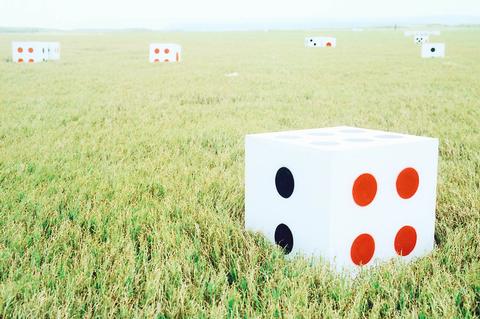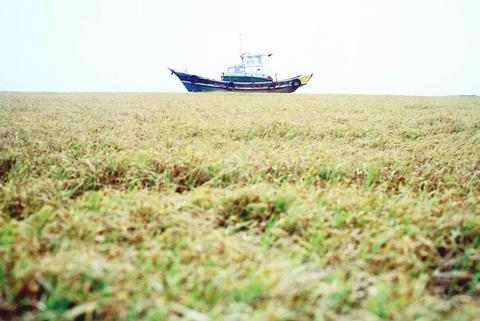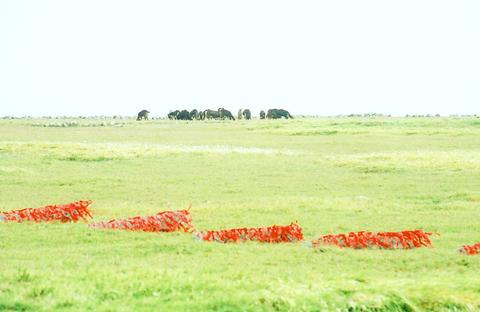As the first harsh autumnal winds sweep over Penghu, chasing off the last tourists, the tropical islands are left to hibernate through the winter, till the next spring brings back the cactus flowers, divers and beach strollers that have long frequented the island. This year, things are different. The meadows are dotted not with dying chrysanthemums, as in every previous November, but alive with a party of strange blooms, rolling dice, shining trails of silver feathers and other fantastic creations.
The plot of land, vibrant with curious installations, is the main stage of the Penghu International Earth Art Festival (

PHOTO: DAVID VAN DER VEEN, TAIPEI TIMES
The cows grazing next to the exhibition indicate that venue is actually Er-kan village's Chun Shen Farm (群生牧場), situated on a cliff jutting out into the Taiwan Strait on Hsi-yu.

PHOTO: DAVID VAN DER VEEN, TAIPEI TIMES
Organized by the Penghu Cultural Bureau, the event is the latest effort by the archipelago to establish its new identity as a home for art, after the Tungpan art village project in June. It also aims at attracting tourists in winter, an unlikely season for tourism development due to the islands' unabating gales.
Earth art, or land art as some call it, refers to open-air works that integrate their surrounding environs. The art form may be new to Taiwan, but it has a long history in Penghu. Chimei County's double heart-shaped stone reef (雙心石滬) and Suokang County's shi-kan-dang (石敢當), or demon-repelling towers, are two famous examples.

PHOTO: DAVID VAN DER VEEN, TAIPEI TIMES N
"The heart-shaped stone reefs that line the coast of Wangan and Chimei [counties] were ingenious fishing devices built by fishermen in the past. The tourists that later came to the island thought they were works of art because of their beauty. Land art is just a name invented by outsiders. The residents have lived among these beautiful things for centuries," said Chen Fu-chi (
The best-known proponent of contemporary land art is Bulgarian-born Christo, who has "packaged" the Reichstag in Berlin, erected a huge fence in California and installed other high-profile works.
To localize the event on Penghu, the organizers, L'orangerie International (
Chen Shun-chu (
Sibala Landscape (希巴拉風景) deals with the current debate of whether or not to build casinos on the island. "The first time I saw the large meadow where we were going to work, it reminded me of Siberia and Scotland -- poetic places. I felt like Su Wu (蘇武)," its creator, Tsong Pu (莊普) said, referring to the legendary character who was banished by a Han-dynasty emperor to become a shepherd on the outskirts of the country.
This pristine tranquility will soon come under siege by the artificial, as he shows by scattering several over-sized dice over the meadow. The shape and color scheme of the dice (sibala in Taiwanese) stand in sharp contrast with the meadow and weigh heavily on the weathered grass. "I wonder what people intend to see when they put something artificial in a natural environment. Is it the sight of civilization or a spoiled nature?" he asked.
The works by local artists stand out with their unassuming sincerity. Sheu Tsu-kuey (
The most eye-catching work in the exhibition is Martin Minto Fang's (
Japanese installation artist Ken Kageyama, famous for his Here Upon series influenced by Zen Buddhism, and Christo's compatriot sculptor Todor Todorov, who was part of the Hualien Stone Sculpture Festival in September, were invited to create new works for the festival, giving it a global perspective. Although their works here do not seem to live up to their fame, the maturity of their works nonetheless serve as good examples of land art for local artists.
Because an overwhelming portion of the government budget was earmarked for an accompanying seafood festival, the festival had to make do with limited money with which to recruit artists and fund their works.
"I think we've managed to come up with the best possible results for a first-time event. There are still things to improve, but we hope it will successfully introduce the concept to Taiwan," said Hsu Hsiao-kuei (徐孝貴), project manager of L'orangerie International(橘園國際).
It may be a quite a while before the Penghu festival can rival Sydney's Sculpture by the Sea event, which ends today, but by going to Penghu this year you'll be able to see the beginning of something great.

Wooden houses wedged between concrete, crumbling brick facades with roofs gaping to the sky, and tiled art deco buildings down narrow alleyways: Taichung Central District’s (中區) aging architecture reveals both the allure and reality of the old downtown. From Indigenous settlement to capital under Qing Dynasty rule through to Japanese colonization, Taichung’s Central District holds a long and layered history. The bygone beauty of its streets once earned it the nickname “Little Kyoto.” Since the late eighties, however, the shifting of economic and government centers westward signaled a gradual decline in the area’s evolving fortunes. With the regeneration of the once

Even by the standards of Ukraine’s International Legion, which comprises volunteers from over 55 countries, Han has an unusual backstory. Born in Taichung, he grew up in Costa Rica — then one of Taiwan’s diplomatic allies — where a relative worked for the embassy. After attending an American international high school in San Jose, Costa Rica’s capital, Han — who prefers to use only his given name for OPSEC (operations security) reasons — moved to the US in his teens. He attended Penn State University before returning to Taiwan to work in the semiconductor industry in Kaohsiung, where he

In February of this year the Taipei Times reported on the visit of Lienchiang County Commissioner Wang Chung-ming (王忠銘) of the Chinese Nationalist Party (KMT) and a delegation to a lantern festival in Fuzhou’s Mawei District in Fujian Province. “Today, Mawei and Matsu jointly marked the lantern festival,” Wang was quoted as saying, adding that both sides “being of one people,” is a cause for joy. Wang was passing around a common claim of officials of the People’s Republic of China (PRC) and the PRC’s allies and supporters in Taiwan — KMT and the Taiwan People’s Party — and elsewhere: Taiwan and

Perched on Thailand’s border with Myanmar, Arunothai is a dusty crossroads town, a nowheresville that could be the setting of some Southeast Asian spaghetti Western. Its main street is the final, dead-end section of the two-lane highway from Chiang Mai, Thailand’s second largest city 120kms south, and the heart of the kingdom’s mountainous north. At the town boundary, a Chinese-style arch capped with dragons also bears Thai script declaring fealty to Bangkok’s royal family: “Long live the King!” Further on, Chinese lanterns line the main street, and on the hillsides, courtyard homes sit among warrens of narrow, winding alleyways and